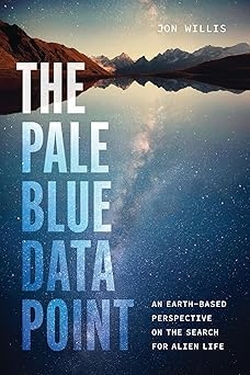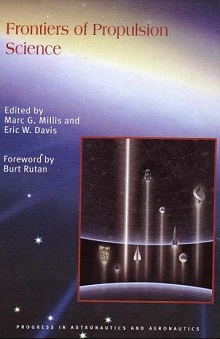Centauri Dreams
Imagining and Planning Interstellar Exploration
Remembering ‘Saturn by 1970’
One day in the late summer of 1958, at a time when the Jet Propulsion Laboratory was still in the hands of the U.S. Army (the transfer to NASA wouldn’t happen until the end of that year), Freeman Dyson and Ted Taylor showed up at the facility outside Pasadena. Try to imagine the scene: At the time, JPL was busy building the Explorer 6 satellite, all 65 kilograms of it. And here came two Project Orion scientists talking about not just satellites but auxiliary vehicles, additional payload to fly aboard their proposed 4000 ton spacecraft that they hoped would explore the outer planets.
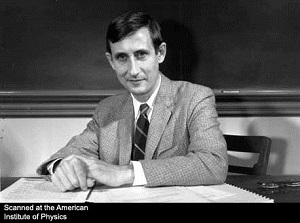
“The reception there was rather cool,” Dyson would later say. “The lady at the front office decided Taylor and I were a pair of crackpots and tried to get rid of us. After about half an hour of arguing we got inside and then it all went very well.”
Image: Freeman Dyson, whose payload ideas must have confounded the team working on early Earth satellites. Credit: Courtesy of Princeton University Archives. Princeton University Library.
The entertaining tale is told in George Dyson’s Project Orion: The True Story of the Atomic Spaceship (Henry Holt, 2002), and it’s easy to see why even hardened rocket scientists would be confounded by what the duo proposed. By mid-1958, the largest payload ever lifted into orbit was Sputnik III, weighing in at 1325 kilograms. Project Orion was intended to loft 1600 tons to low-Earth orbit, or in its advanced version, 1300 tons to a landing on one of Saturn’s moons. The moon that most drew Dyson’s eye in 1958 was tiny Enceladus.
When I wrote about this in connection with the recent findings of an ocean within the distant moon, I was delighted to receive the diagram below from George Dyson, which shows the numbers as tabulated by Freeman Dyson in 1958, when details about the outer planets’ moons were sketchy at best. I want to run this as a bit of deep space history, the working figures that would later turn into Freeman Dyson’s document “Trips to Satellites of the Outer Planets, which was declassified in 1987.

Image: Thinking about deep space destinations in 1958, as the Orion team pondered their best options for a trip that might take place as early as 1970. Credit: Freeman Dyson, courtesy of George Dyson.
With reference to the figures, George Dyson comments:
“Note that the .618 density for Enceladus was not a transcription or arithmetic error, it is due to the mass and radius of the outer planet satellites being known only approximately at that time. (I believe Thomas “Tommy” Gold was brought in as a consultant on the question of selecting landing sites.) These calculations were made to determine the best destination both in terms of an optimum velocity match and highest probability of being able to obtain water ice or hydrocarbons on the surface to replenish the vehicle’s propellant mass.”
Below is the title page of the “Trips to Satellites of the Outer Planets’ report.

Image credit: Freeman Dyson, courtesy of George Dyson.
We’ve discussed Orion many times in these pages, though it’s been long enough that it may be time for a general review in the near future. Most Centauri Dreams readers will be familiar with George Dyson’s definitive book on the project’s history, and with the overall concept of detonating nuclear devices behind the craft, with a system of pusher plates and shock absorbers to cushion the crew, and the capability of launching payloads that were mind-boggling in the days of Sputnik. Interestingly, Mars was the first destination the team had in mind, though a landing on the Moon along the way would have been part of that mission. A four or five year mission seemed a possibility, one that Freeman Dyson would liken to the voyage of Darwin’s Beagle.
But the allure of the outer planets and their satellites was hard to resist, particularly when you threw in two ways to make the mission lighter and more efficient. For one thing, it was possible to use atmospheric braking (‘aerobraking’) to reduce propellant mass. I’ll quote from George Dyson’s book on the other:
The second part of the strategy is to gather propellant for the return trip at the destination, thereby reducing the average takeoff weight of the bombs. “We assume that we can use as propellant either ice, ammonia, or hydrocarbons,” wrote Freeman, explaining why Enceladus was such a good place to stop. “We suppose that each propulsion unit contains one-third of its mass in the form of the bomb and other fabricated parts, and two-thirds of its mass in the form of propellant. This means that, when propellant refueling is possible, only one-third of the mass required for the homeward trip need be carried out from Earth.” When you put these numbers together, the end results were astonishing. “With the use of atmospheric drag a round-trip to satellites of either Jupiter or Saturn could be made with a total velocity increment of the order of 40 km/sec. With refueling and braking, all the satellites become accessible with a round-trip mass-ratio less than 2.”
The Mars ship can thus become an outer planet ship that refuels along the way. And given the document shown above, I have to close with this last quote from the book:
Forty years later, Freeman and I review a two-page handwritten General Atomic calculation sheet, “Outer Planet Satellites,” dating from 1958 or 1959. It lists, for nine different satellites, ten different parameters such as orbital velocity, escape velocity, density, and gravity that determine the suitability of the satellites as places to land. Freeman smiles as he carefully studies the numbers.
“Enceladus still looks good,” he says.

Digging into the Late Heavy Bombardment
The Barberton greenstone belt is considered one of the oldest pieces of continental crust on the planet. About 100 kilometers long and 60 kilometers wide, the belt is in South Africa east of Johannesburg and not far from the border of Swaziland, a region where gold was first discovered in South Africa. Greenstone belts, however, are numerous, widely distributed geographically and throughout geological history, all of them marked by the characteristic green hue imparted by the metamorphic minerals within their rocks. The Barberton greenstone belt is now yielding evidence of a massive ancient impact well over three billion years old.
The paper on this work is slated to appear in the journal Geochemistry, Geophysics, Geosystems, where scientists will make the case that the impact they are tracking occurred 3.26 billion years ago at the end of the Late Heavy Bombardment, a period between three and four billion years ago when numerous large asteroids are thought to have struck the planet. The impact may have caused a major shift in plate tectonics, and characterizing it will help us better understand the conditions life struggled against in its earliest evolution.
It is possible that changes to the environment caused by impacts like this one may have wiped out existing microscopic organisms, only to allow other organisms to evolve. What’s mind-boggling here is the sheer size of the event. Have a look at the graphic below, and note in particular the comparison of the impact crater to the island of Hawaii.
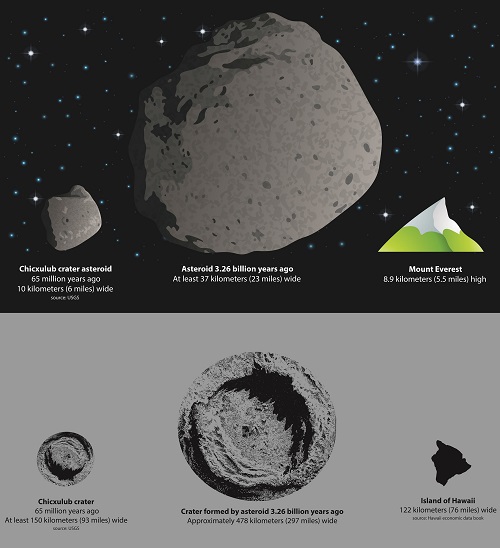
Image: A graphical representation of the size of the asteroid thought to have killed the dinosaurs, and the crater it created, compared to an asteroid thought to have hit the Earth 3.26 billion years ago and the size of the crater it may have generated. A new study reveals the power and scale of the event some 3.26 billion years ago which scientists think created geological features found in a South African region known as the Barberton greenstone belt. Credit: American Geophysical Union.
The asteroid, according to this American Geophysical Union news release, would have been three to five times larger than the Chicxulub impactor considered to have played a huge role in the extinction of the dinosaurs. Striking the Earth at 20 kilometers per second, the object would have created a crater nearly 500 kilometers across, a larger jolt than a 10.8 magnitude earthquake, creating tsunamis thousands of meters deep. The researchers believe the sky would have become red hot and the tops of the oceans would have boiled.
“We are trying to understand the forces that shaped our planet early in its evolution and the environments in which life evolved,” said Donald Lowe, a geologist at Stanford University and a co-author of the study. As to the asteroid itself, Lowe added, “”We knew it was big, but we didn’t know how big.” The team’s model shows that while the Chicxulub event is estimated to have released a billion times more energy than the Hiroshima and Nagasaki bombs, this more ancient impact would have been far more powerful, and it was just one of many in the Late Heavy Bombardment.
The actual site of most of the impacts during the LHB is unknown, the victim of erosion, crustal movement and evolving geology, and the researchers believe the asteroid they are studying impacted thousands of kilometers away from the Barberton greenstone belt, though its seismic waves would have been responsible for the geological formations found in the region. Clearly the early Solar System was a chaotic and dangerous place, one in which the great experiment of life was under continuous threat. To map an impact that occurred more than three billion years ago is to chart the dimensions of ancient catastrophe, a time when vaporized rock fell as rain.
The paper is Sleep et al., “Physics of crustal fracturing and chert dike formation triggered by asteroid impact, ~3.26 Ga, Barberton greenstone belt, South Africa,” to be published in Geochemistry, Geophysics, Geosystems (abstract).

A Tantalizing Exomoon Possibility
Gravitational microlensing is a phenomenally interesting way to find unusual things in the cosmos. A closer star can bend space around itself enough that, when it passes between us and a more distant star, a distinct brightening of the distant star’s light is apparent, a lens effect. That’s a useful phenomenon in its own right, and gravitational lensing involving distant galaxies is a significant part of some astronomers’ toolkits. But we can also use the effect when looking for exoplanets, and in the case of recent work, even a candidate for an exoplanet’s moon.
The method works in this context because if the foreground star has a planet orbiting it, a second lensing event can occur, and a comparison between the two brightening events can help us figure out the relative mass of the two objects. The problem with microlensing is that these are one-shot events, dependent on chance celestial alignments. In other words, we can’t go back and study them a second time. That’s a shame, because some studies have found what appear to be free-floating planets, an interesting find we’d like to learn much more about.
Now we have MOA-2011-BLG-262, a microlensing observation made by the Japan-New Zealand-American Microlensing Observations in Astrophysics (MOA) and the Probing Lensing Anomalies NETwork (PLANET) programs, working with telescopes in New Zealand and Tasmania. The work shows two objects, one of them about 2000 times smaller than the other. We are looking at either a small star and a planet about eighteen times as massive as Earth around it, or else a planet larger than Jupiter orbited by a moon less massive than Earth.
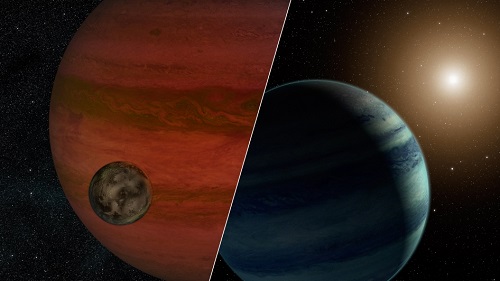
Image: Researchers have detected the first “exomoon” candidate — a moon orbiting a planet that lies outside our solar system. Using a technique called “microlensing,” they observed what could be either a moon and a planet — or a planet and a star. This artist’s conception depicts the two possibilities, with the planet/moon pairing on the left, and star/planet on the right. If the moon scenario is true, the moon would weigh less than Earth, and the planet would be more massive than Jupiter. Credit: NASA/JPL-Caltech.
The exomoon option seizes the attention because exomoons have yet to be detected, and pushing the limits of detectability down to this scale is a real achievement. But why the wide range between the two possibilities? The problem is that we don’t know how far away the two objects are. If they’re closer to the Earth, they’ll produce the same effect as a more massive pair — planet around star — would at a considerably larger distance. It’s possible to use parallax techniques, taking advantage not only of ground-based telescopes but of space assets like the Spitzer space telescope, but we don’t have that data for MOA-2011-BLG-262, which will remain a mystery.
Gravitational microlensing, then, gives us a sudden illumination of a distant stellar system, after which all hopes of future observations disappear. It’s like a sudden beam of light illuminating part of the cosmos whose effects disappear all too quickly, leaving us to ask questions like this one: If this is a rogue planet, and assuming it was ejected from a young planetary system by gravitational interactions there, how did it keep its moon, and how likely are such scenarios?
Meanwhile, we continue with the other methods in our arsenal, as highlighted, for example, by David Kipping’s Hunt for Exomoons with Kepler project, in hopes of answering questions about more conventional moons in actual solar systems. The paper is Bennett et al., “MOA-2011-BLG-262Lb: A Sub-Earth-Mass Moon Orbiting a Gas Giant Primary or a High Velocity Planetary System in the Galactic Bulge,” The Astrophysical Journal Vol. 785, No. 2 (2014), 155 (abstract).

ISEE-3: The Challenge of Long Duration Flight
Some mission concepts for interstellar flight demand equipment that can stay functional not just for decades but for centuries. Do we know how to build such things? Missions like Voyager are encouraging in that we have two spacecraft that were never built for the kind of longevity we’ve demanded of them, and we’re still tracking their signals. But as Robert Forward once speculated, the problem may not be just in building the spacecraft, but in how we handle them.
Forward’s issue involved the changes on Earth that might occur over a long-duration spaceflight like the one he envisioned in Rocheworld (1984, first published as Flight of the Dragonfly). A crewed starship is actually on the way to Barnard’s Star, dependent on the massive laser installations in the Solar System whose beam will allow it to decelerate (through ‘staging’ the sail) into the destination star system. But there is a movement afoot on Earth to shut down the beam, motivated by money, politics and the usual cast of miscreants. The technology, in other words, works, but the question is whether the humans behind it will make the right decision.
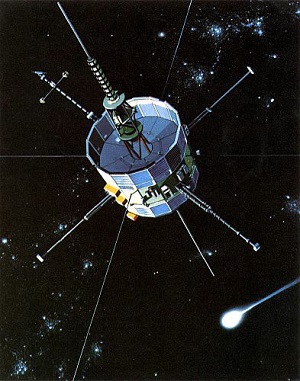
Much goes on in Rocheworld and the question of shutting down the laser is but a minor theme, but the question Forward raises is intriguing. Consider what’s happening with the International Sun-Earth Explorer-3 (ISEE-3), a spacecraft launched in 1978 to make observations of the solar wind’s interactions with Earth’s magnetosphere. Back in 1983, ISEE-3 turned into ICE, the International Cometary Explorer, and in that guise studied comet Giacobini-Zinner and later Halley’s comet. NASA even turned the craft loose after that to study coronal mass ejections before decommissioning the probe and closing down its systems.
This August, as the Planetary Society’s Emily Lakdawalla has noted, the spacecraft in its heliocentric orbit will be catching up with the Earth from behind, which creates an interesting issue of its own. Although officially out of service, ISEE-3 has been broadcasting a carrier signal that was detected in 2008. It’s also known that as of last check — this was some time in the 1990s — twelve of its thirteen instruments were still working. Could we get the 36-year old spacecraft back in service? It’s a compelling thought, but a tough task to accomplish.
Image: The ISEE-3/ICE spacecraft. Can it be returned to use? Credit: NASA.
The problem isn’t with the data from the spacecraft, which can be accessed by the Deep Space Network. The issue is our ability to talk to the probe. The Goddard Space Flight Center team responsible for the craft maintains a Facebook page, from which Lakdawalla quotes:
The transmitters of the Deep Space Network, the hardware to send signals out to the fleet of NASA spacecraft in deep space, no longer includes the equipment needed to talk to ISEE-3. These old-fashioned transmitters were removed in 1999. Could new transmitters be built? Yes, but it would be at a price no one is willing to spend. And we need to use the DSN because no other network of antennas in the US has the sensitivity to detect and transmit signals to the spacecraft at such a distance.
However, all hope is not lost. ISEE-3’s signal has been detected by the Allen Telescope Array as well as by radio amateurs, and scientists at the Applied Physics Laboratory are studying potential new, lower-power ways of contacting the probe, as Lakdawalla reports in a later update. If the craft’s engines can be commanded to fire, it could be recaptured into a halo orbit at the L1 Lagrangian point and returned to service. The odds are long and time is short — the engine firing needs to be accomplished no later than early June — but the fact that the APL team is actively working on this inspires me to keep an eye on the ISEE3returns Facebook page.
ISEE-3 is not, obviously, a manned mission, so the question of reactivating it has none of the life-or-death drama of the Forward novel. But it’s an interesting commentary on how our technology can sometimes expose our weaknesses. In this case, we have a functioning spacecraft that could conceivably come back into use, one that is for now rendered impotent until we can pull the resources together to use it. The cost factor speaks for itself, and it’s understandable. But I’m reminded of our problems reading old data from the Pioneer days because the equipment has become obsolete. Truly long-term thinking involves planning for changing formats and technological upgrades, a subject about which we’ll be learning much more as we contemplate deeper and longer missions into the dark between the stars.

Optimal Worldship Populations
Although we tend to focus on propulsion as the major obstacle to reaching another star, the biological problems that go along with journeys lasting decades or even centuries are equally daunting. If we could devise methods that would get us to Alpha Centauri within a century, we’d still face the need to keep a crew alive within a sustainable closed ecosystem for that amount of time. If we’re talking humans in starships, then, we need a lot more data about how people interact in isolated communities, stay healthy, and manage critical self-sustaining systems.
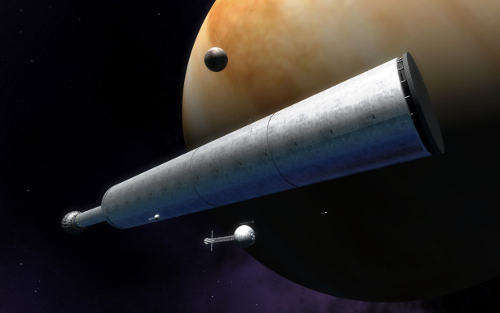
Image: A habitat for humans over generations, a worldship poses critical questions about survivability and genetic diversity. Credit: Adrian Mann.
Centauri Dreams readers will recall Cameron Smith’s interest in these matters, as reflected in his article Biological Evolution in Interstellar Human Migration, published here last March. The author of Emigrating Beyond Earth: Human Adaptation and Space Colonization (Springer, 2012), Dr. Smith (Portland State University) looks at these issues over the course of generations. How large does a starship crew have to be in order to keep the population healthy? This article in Popular Mechanics gives a nice overview of Smith’s findings, which were published in Acta Astronautica and flesh out his earlier essay in these pages. The work was performed as a contribution to Icarus Interstellar and its Project Hyperion.
Working with William Gardner-O’Kearney, Smith constructed simulations to create scenarios for interstellar travel with the help of MATLAB, a widely used tool for numerical computation. One immediate result was to draw into question earlier calculations by John Moore (University of Florida), who had found that a 2000 year voyage aboard a generation ship would require an initial crew of no more than 150. In sharp contrast, Smith found that a minimum of 10,000 was necessary, while 40,000 would be a safer number still given the perils of the journey. Starting population size, which the duo calculated over 30 generations, is a crucial matter.
A key issue, as you would expect, is genetic diversity. Small groups like the Amish and Ashkenazi Jews suffer higher rates of diseases like cystic fibrosis and Tay Sachs largely because of intermarriage between relatives. I’ll send you to the article for the bulk of the researchers’ graphs, but I’ll show one below, illustrating what happens within groups of different sizes over time. A ship starting out with a crew of 150 loses 80 percent of its genetic diversity after thirty generations. Even 500 is too small a number, for it does not represent a wide enough swath of the human population. Somewhere between 10,000 and 40,000 is where we find a starting population that can maintain 100 percent of its original genetic variation.
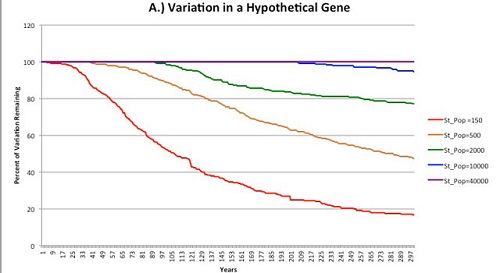
Image: The decline in genetic diversity among smaller populations over time is evident here. Note the 150 line in red at the bottom of the chart, with the most robust, in purple and representing a starting crew of 40,000, shown at the very top. This number maintains 100 percent diversity. Credit: Cameron Smith/Gardner O’Kearney.
Just as we preserve a healthy gene pool with a larger population, we also safeguard against external risks, the kind of catastrophe that could snuff out the entire population of a small ship. This work makes the case that housing tens of thousands of colonists in a single generation ship would be a mistake. Far better, when launching our expedition, to use multiple ships, traveling perhaps close enough together for trade and other human interactions, but separated so that a single disaster wouldn’t mean the end of the entire venture. I’m invariably reminded of the expedition led by Sky Haussmann in Alastair Reynolds’ novel Chasm City (2001), a fleet of starships that confronts a human-caused calamity.
10,000 seems to be the minimum number for success. Says Smith: “With 10,000, you can set off with good amount of human genetic diversity, survive even a bad disease sweep, and arrive in numbers, perhaps, and diversity sufficient to make a good go at Humanity 2.0.” That’s a large crew, but history has shown us that there are always pioneers, adventurers, misfits and any number of other psychological types willing to give up everything they have known to chance their future in unknown lands. The guess here is that if a fleet of five generation ships needing crews of 2000 each is ever built, it will not lack for volunteers.
The paper is Smith, “Estimation of a genetically viable population for multigenerational interstellar voyaging: Review and data for project Hyperion,” Acta Astronautica, Vol. 97 (2014), pp. 16-29 (abstract).

On the Enceladus Ocean
The recent news about an ocean on Enceladus had me thinking over the weekend about a trip my wife and I took years ago to Michigan’s Upper Peninsula. There we had rented a cabin for the week on the shores of Lake Superior, twenty miles from the nearest town, unless you counted the small grocery store, art gallery and scattered houses up the highway as a town — if so, it was a tiny one. Looking out across the silver and gunmetal gray waves of Superior, you could imagine it an ocean, a cold, frothing place of treacherous currents and, that October, raw winds.
Lake Superior appears as the comparison in many of the reports on the Enceladus findings as they sketch out what appears to be a sea just as large, perhaps ten kilometers deep covered by an ice shell four times as thick. Given that the well known plumes of Enceladus are already known to contain organic molecules in addition to salty water, the inevitable question arises: Could some form of life exist beneath this frozen surface? There’s no way to tell as yet, but the imperative to probe still further into the tiny world (504 kilometers in diameter) continues to grow.
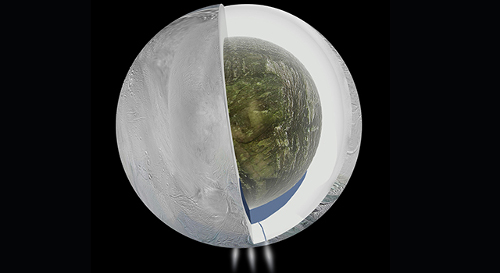
Image: This diagram illustrates the possible interior of Saturn’s moon Enceladus based on a gravity investigation by NASA’s Cassini spacecraft and NASA’s Deep Space Network, reported in April 2014. The gravity measurements suggest an ice outer shell and a low density, rocky core with a regional water ocean sandwiched in between at high southern latitudes. Views from Cassini’s imaging science subsystem were used to depict the surface geology of Enceladus and the plume of water jets gushing from fractures near the moon’s south pole. Credit: NASA/JPL-Caltech.
What we have in the latest work is the result of three Cassini flybys, two of them over the southern hemisphere, one over the north. The tiny deviation of the spacecraft from its trajectory — the velocity change was 0.2-0.3 millimetres per second — could be detected in Cassini’s radio signals, helping us measure variations in the gravity of the tiny world. The payoff is explained by Luciano Iess (Università La Sapienza, Rome), lead author of the paper in Science:
“By analysing the spacecraft’s motion in this way, and taking into account the topography of the moon we see with Cassini’s cameras, we are given a window into the internal structure of Enceladus. The perturbations in the spacecraft’s motion can be most simply explained by the moon having an asymmetric internal structure, such that an ice shell overlies liquid water at a depth of around 30-40 km in the southern hemisphere.”
These measurements are extraordinarily fine, but analysis of the Cassini signal can detect changes in velocity as small as 90 microns per second, according to this JPL news release. Although the southern polar region has a surface depression that affects the local pull of gravity, the magnitude of the gravitational dip is less than it ought to be given the size of the depression, which leads to the finding that a high density feature beneath the surface is the cause. Denser material, probably liquid water, compensates for the missing mass. This water may or may not be the source of the south pole plumes Cassini has observed in the past, but that possibility certainly exists.
Meanwhile, I’m recalling an earlier encounter with Enceladus. Freeman Dyson was talking about the moon as a target for the Orion spaceship in the late 1950s, and in a twelve-page report in 1958 called “Trips to Satellites of the Outer Planets,” he made the case for visiting the gas giant moons. Decades later, he would explain his thinking to his son George, as recounted in the latter’s Project Orion: The True Story of the Atomic Spaceship (Henry Holt, 2002):
“We knew very little about the satellites in those days. Enceladus looked particularly good. it was known to have a density of .618, so it clearly had to be made of ice plus hydrocarbons, really light things, which were what you need both for biology and for propellant, so you could imagine growing your vegetables there. Five-one-thousandths g on Enceladus is a very gentle gravity — just enough so that you won’t fall off.”
Amazing to recall that, at least for a time, the motto of Project Orion was “Saturn by 1970.” But it’s clear from everything we’ve learned about this moon since that Enceladus remains a primary object for study, even if we’ve now moved into the realm of astrobiology. What a surprise that would have been to the Orion team back in the 1950s!
The paper is Iess et al., “The gravity field and interior structure of Enceladus,” Science Vol. 344, No. 6179 (4 April 2014), pp. 78-80 (abstract).

